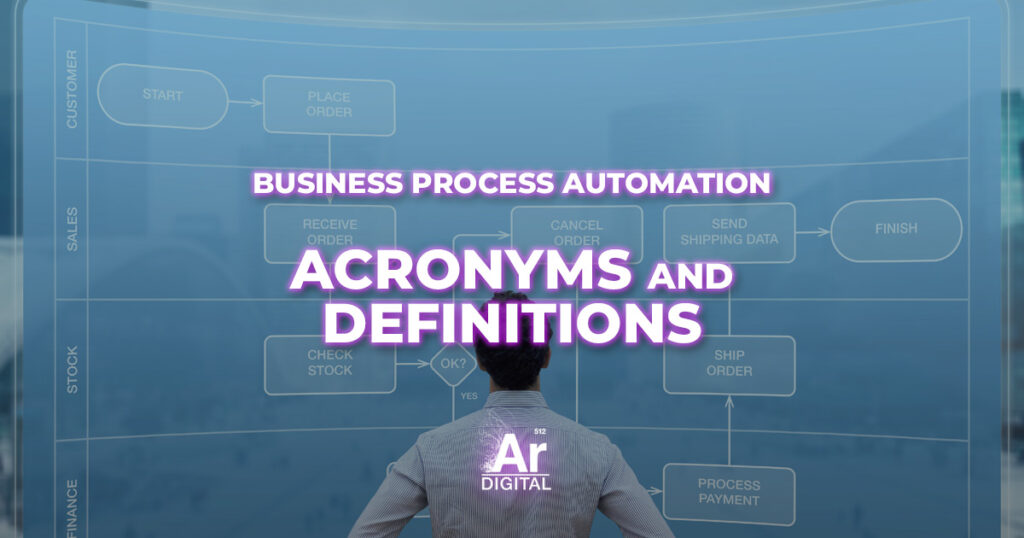Defining Automation Terms
We’ve heard a lot recently about various flavors of automating portions of a business process: workflow automation, robotic process automation, enterprise automation, business process automation, and hyperautomation. Even within our own teams, these terms are often used to mean different things. The goal of this post is to clarify these related, but often confused, terms.
Workflow Automation
IBM defines workflow automation as optimizing “processes by replacing manual tasks with software that executes all or part of a process” (IBM 2021).[1] ”Workflow automation” is the generic term that encompasses all flavors of business automation. Workflow automation is broken down into two types: robotic process automation (RPA) and business process automation (BPA).
Workflow automation tools run the gamut from simple to complex, starting with bots that can do simple data entry tasks and progressing to the use of artificial intelligence (AI) to analyze your data to figure out what you have and actually use.
Robotic Process Automation
RPA is defined by Gartner as “a productivity tool that allows a user to configure one or more scripts (which some vendors refer to as “bots”) to activate specific keystrokes in an automated fashion” (Gartner retrieved 2022). [2] That is, these scripts can do the same things humans do on computers, such as manually entering data, processing invoices, correcting data errors, and handling basic customer support inquiries.
While RPA isn’t likely to automate an entire end-to-end process, it can add efficiencies for those steps where humans are slow or error-prone, such as manual data entry. The great news is that RPA can be used on top of existing applications, meaning you don’t have to replace existing systems to add efficiencies. Please note this does NOT mean you need to have tiny robots running around your office floor to have implemented RPA!
Not sure where to use RPA? Here are some use cases to consider:
- Manual data transfer from one system to another. If your team spends a lot of time swivel-seating between platforms, RPA can automate that for you. This frees up your team to focus on more complicated tasks while also reducing the number of data entry errors.
- Updating customer information. RPA can extract data from a document, email, or online form and update customer information. This activity is ubiquitous across industries.
- Generating contracts. RPA can aggregate data from internal and external sources to assemble a contract that is quickly delivered to your customer.
Business Process Automation
Gartner defines Business Process Automation (BPA) as “the automation of complex business processes and functions beyond conventional data manipulation and record-keeping activities, usually through the use of advanced technologies” (Gartner retrieved 2022).[3] The emphasis on advanced technologies differentiates business process automation from RPA. While RPA relies on scripts, BPA tools encompass a range of solutions, including low-code/no-code technologies, software platforms, custom integrations, integration process-as-a-service (iPaas), and AI.
Many situations lend themselves well to business process automation, including these:
- Customer Support | Chatbots allow for quick interactions with customers through messaging apps and can go well beyond the use of RPA, incorporating natural language processing and AI to help customers, allowing support staff to focus on more difficult issues.
- Workforce Development | Automation allows HR teams to automatically review resumes for candidates that best meet the job qualifications.
- Contract Management | Need to generate contract documents, verify that the people you’re interacting with are real, and collect e-signatures? While RPA can help you generate a contract quickly, business process automation can make workflows, approvals, and the customer experience better and faster.
- Accounting (AP/AR) | Automation allows companies to generate both payments and invoices in the correct format and send them out at the correct time to eliminate errors and lost revenue.
- Capital Equipment Leasing | Automation allows manufacturers to increase origination speed and reduce portfolio risk by creating an accurate view of customer credit profiles, limits, exposure, assets , and contracts. This is especially helpful when manufacturers look to securitize their leases in order to reinvest in their manufacturing processes.
Enterprise Automation
Most people use the term enterprise automation in a way that is synonymous with Business Process Automation. Similar to BPA, enterprise automation platforms typically involve integrating disparate technology systems to pass data and automate various business processes. We mention it to make it clear; it is not something different.
Where Does Hyperautomation Fit In?
Hyperautomation is a process for automating as much of an organization’s business processes as possible as fast as possible using a disciplined approach to identify those areas where automation can and should be applied. In other words, hyperautomation is really a buzzword for “automate everything”. Both RPA and BPA are considered and applied where needed. The cool part of hyperautomation is that some organizations are even using a combination of RPA, AI, and machine learning (ML) to automate the analysis when determining what processes are good candidates for automation.
Now, What to Automate?
This whole article might feel a bit like a buzzword salad. That’s why we wrote it – we felt it too and wanted to add clarity around our use of these terms with our own clients. From here, you can read our other articles to facilitate doing requirements for business process automation projects and how to measure whether they are going well.
Sources
[1] https://www.ibm.com/cloud/blog/workflow-automation retrieved 9/27/2022
[2] https://www.gartner.com/en/information-technology/glossary/robotic-process-automation-rpa retrieved 9/27/2022
[3] https://www.gartner.com/en/information-technology/glossary/bpa-business-process-automation retrieved 9/27/2022




